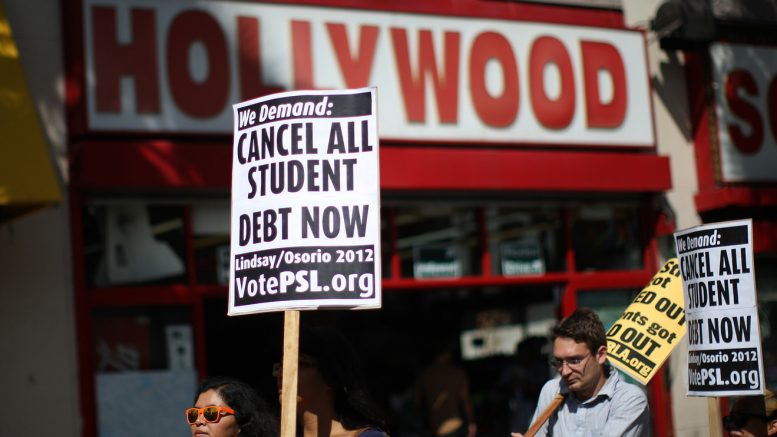A student loan giant has agreed to suspend collection activities on the debt of certain borrowers who filed for bankruptcy, providing at least temporary relief for potentially thousands of people and signaling that there may be a viable path to discharging some student debts in bankruptcy.
As part of an ongoing class-action lawsuit filed against student loan servicer Navient, the company has voluntarily agreed to stop collection activities on loans used by borrowers who filed for bankruptcy after October 2005 and used the loans to attend nonaccredited programs, while the case winds its way through the court system. Under the voluntary agreement filed with the court Thursday, Navient can still continue to send these borrowers monthly statements, but the company will no longer aggressively pursue the debts through means such as multiple daily phone calls until the outcome of the case is determined.
In the suit, the plaintiffs claim that Navient attempted to collect on loans that were discharged in bankruptcy, including by calling relatives and employers multiple times a day. Patricia Christel, a Navient spokeswoman, declined to comment on pending litigation. But she wrote in an email statement that the company supports reform that would allow borrowers to discharge their debts in bankruptcy if they’ve made a good faith effort to repay their loans over several years and are still struggling.
Student debt is nearly impossible to discharge in bankruptcy, the conventional wisdom goes, but a group of attorneys has been using various strategies to challenge that notion with some success in cases filed across the country. If they win, the class-action suit could represent one of the bigger legal victories in this battle because it would apply to a large group of borrowers — potentially 16,000 the plaintiff’s attorneys estimate — with loans held by a major company.
“The more of these cases we keep winning, it seems to show this is the right theory of the law,” said Austin Smith, one of the attorneys representing the plaintiffs. “More and more courts are accepting this.”
Beginning in the 1970s Congress made changes to the bankruptcy code to make it more difficult for borrowers to use the process to get rid of their student loans. These days, a debt can’t be discharged if it falls into one of these categories: a federal student loan, a loan made under a program funded in whole or in part by a nonprofit (typically loans made by the school), a qualified education loan — this can be a loan made by a for-profit company, but needs to be made for qualified educational expenses, typically defined as the cost of attendance, for a student attending an eligible institution — or funds received for “an educational benefit.”
The only way for borrowers to get rid of the debts that fall into these categories in bankruptcy is to prove that repaying the loan would cause an “undue hardship” — a notoriously hard legal standard to meet. But in this case and others, Smith and other attorneys have argued that companies are collecting on debts that don’t actually fall into any of these categories and therefore were discharged in bankruptcy.
Those include loans used for nonaccredited programs such as: career training, bar exam study, K-12 education and medical schools in the Caribbean, among other categories.
For years, attorneys have largely been challenging the dischargeability of student debt in bankruptcy by trying to expand the definition of undue hardship, but the case law is so developed in that area, bankruptcy judges often feel they have little leeway to grant a discharge, said Dalié Jiménez, a professor at University of Connecticut’s School of Law. In most jurisdictions, a debt is defined as an undue hardship if the borrower can’t pay it back now and there’s no reason to believe they’d be able to pay it back in the future.
Focusing on whether the loans are dischargeable in the first place offers another way for attorneys to help borrowers in bankruptcy get rid of their debts that judges may be receptive to, said Jiménez, who was on the founding staff or the Consumer Financial Protection Bureau. Bankruptcy judges know that the country’s student loan situation has changed dramatically since Congress first exempted student debt from bankruptcy discharge — the number of borrowers and size of their debts has exploded — but they may be bound by legal precedent that prevents them from using the undue hardship standard to get rid of the loans.
“There’s a willingness, maybe even a desire by some (judges) to re-examine which student loans are dischargeable,” she said.
The judge overseeing the class-action hasn’t made a ruling yet on the facts of the case, so it’s unclear if he believes the debts should be discharged. But in a hearing to discuss whether Navient would stop collection on the loans at issue in the case, he pushed the company to do so voluntarily, expressing sympathy for the borrowers in this predicament.
“I’m going to assume that Navient is a responsible corporate citizen,” the judge said, according to a transcript of the hearing, “and it would seem to me that a responsible corporate citizen,if it thought that there might be a chance that things weren’t being done exactly the right way, that they would want to get out in front of this.” He later added “It would seem to me to be the right thing.”
It’s still too early to say if the case will result in permanent relief for these borrowers and even if it does, they still represent a small slice of borrowers with student loans overall, said John Rao, an attorney at the National Consumer Law Center. Still, the case represents important progress in efforts to help struggling student loan borrowers in bankruptcy, in particular because a victory in a class action means that borrowers who may not have known their rights could stand to benefit, according to Rao.
“It’s not completely hopeless,” he said.
Source: www.marketwatch.com





Be the first to comment on "This Class-Action Lawsuit May Offer Hope for Student Loan Borrowers in Bankruptcy"